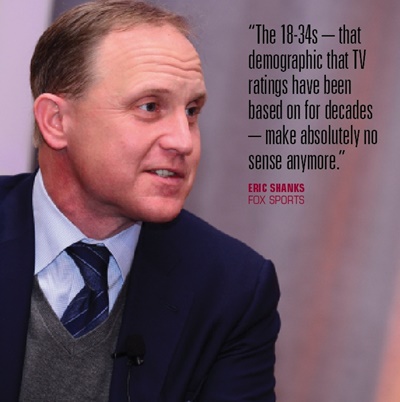TV sports networks, and the advertisers that fund them, have spent the past decade chasing younger viewers. But if sports TV executives have their way, that push to get younger and younger is about to change — not so much that they will target senior citizens, but some of the most influential executives in sports media don’t think 20-year-olds should have the type of influence they currently wield.
There’s been such a focus on reaching millennials that it is refreshing to hear some top media executives say they aren’t as important to TV sports as some may believe. Some of these executives argue that it makes as much sense for advertisers to chase younger millennials — think the 18-to-24 demographic — as it did to chase teenagers a decade ago. Today’s younger millennials have extended their adolescence so much that they shouldn’t be courted by advertisers as much as they have been, they say.
Fox Sports President Eric Shanks cited research that said millennials in the 18-24 demo are much more like teenagers than the 25-34 millennials. On average, the 18-24 set stays in school longer, lives at home longer and doesn’t work normal jobs. They wait much longer to form a household, get married and have kids.
“Millennials make up a big portion of the workforce, but their earning power actually is not very much at all,” Shanks said on a recent panel session at the Paley Center in New York City. “The 18-34s — that demographic that TV ratings have been based on for decades — makes absolutely no sense anymore. Eighteen-to-24-year-olds look much more like teenagers in their consumption habits than 25-plus.”
CBS Sports Chairman Sean McManus sounded a similar theme.
 |
Photo by: RICH SCHMITT PHOTOGRAPHY
|
“We’re less concerned with how you reach the millennials and monetizing them because they don’t have a lot of disposable income,” he said.
That doesn’t mean that these networks are shunning this younger demographic. Network executives still want to produce the sports that appeal to them as a way “to get them into the funnel,” said NBC Sports Group Chairman Mark Lazarus.
“We want to get them into the video consumption funnel,” he said. “[Advertisers] want to get them into the product funnel and build brand loyalty over time.”
Fox Sports has found that the sports that work best with younger viewers are the ones that don’t require long time commitments. Shanks specifically referred to soccer and the UFC as two sports that don’t take too long and do well with younger audiences.
“New media requests put much more of a value on their time than their money because they don’t have any money,” Shanks said. “The sports that request millennials’ time are the ones that are going to have to figure out how to attract millennials the hardest.”
| The numbers for 12-17s and 18-24s are relatively similar, but there's a sharp shift from there to the 25-34s. |
| AGE GROUP |
TIME* |
| 12-17 |
18:15 |
| 18-24 |
18:33 |
| 25-34 |
24:52 |
| AGE GROUP |
TIME* |
| 12-17 |
1:49 |
| 18-24 |
1:42 |
| 25-34 |
3:20 |
| AGE GROUP |
TIME* |
| 12-17 |
3:55 |
| 18-24 |
4:09 |
| 25-34 |
2:56 |
* All figures in hours:minutes. Source: Fox Sports
Speaking on the same panel, ESPN President John Skipper said his network puts an emphasis on sports that are popular with young men, in particular.
“I’m not sure that we spend a whole lot of time talking about targeting specifically towards millennials,” he said. “We do spend time thinking about what sports younger viewers care about. … That’s why our network this weekend has soccer and NBA and lacrosse and college softball.”
The key is to get advertisers to follow suit.
“All of us realize that the content that we have is first class; we’re going to draw the viewers,” McManus said. “The question is, how is the audience going to change in terms of consuming your product and how you get paid for that. The traditional model of selling 30-second spots still works to a large extent, but it’s not the future.”
It’s not the future because TV networks are finding that younger millennials are not consuming video the same way older millennials consume it.
“The more important issue with the millennials is that they spend less than a third of their time watching video [by] watching it on traditional television,” Skipper said. “This is why it has to be about mobile, other kinds of devices and authenticated television.”
John Ourand can be reached at jourand@sportsbusinessjournal.com. Follow him on Twitter @Ourand_SBJ.





